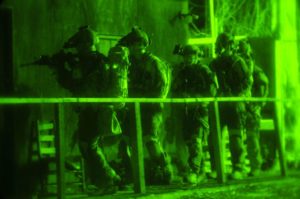When I was a kid growing up in Laredo,Texas, in the 1950s and 1960s, tourists from all over the country would come to Laredo to get a taste of “old Mexico.” Laredo is situated right on the border. The downtown area was connected to the downtown area of Nuevo Laredo with one international bridge. The two cities were essentially one large city separated by the Rio Grande, which serves as the international border.
Tourists would either walk or drive across the bridge for a day of shopping at the market, eat lunch and drink a beer at the Cadillac Bar, and eat dinner, have drinks, and take in a floor show at some nightclub. When I was in high school, that’s what we would also sometimes do on dates (sometimes without the knowledge or consent of our parents). It was all safe and secure. With the exception of sometimes having to pay a bribe to a cop for illegal parking, there were rarely any adverse incidents.
Not anymore. Nobody in his right mind would go into Nuevo Laredo except in a case of extreme necessity. That’s because everyone is now subject to the very real possibility of being killed or kidnapped by drug cartels and drug gangs or caught in the crossfire of drug turf battles.
Why the problem now and not back then?
One simple reason: The war on drugs or, to put it another way, drug illegality. The drug war destroyed the tourism business in Laredo and Nuevo Laredo. In fact, with the exception of well-secured tourist resorts on Mexican beaches, the drug war has essentially destroyed the tourism business across the country. My parents drove from Laredo to Acapulco for their honeymoon. No one in his right mind would do that today.
Take a look at this article from BBC.com. It reports that more than 60,000 people in Mexico have disappeared since 2006, 53 percent of whom were between the ages of 15 and 35. That’s when the Mexican government, on the strong urging of U.S. officials, began a fierce crackdown in the war on drugs, including by using the military. The article reports that “on top of this, more than 31,000 people were murdered in the country last year alone.”
This is what happens when government makes drug use, drug production, drug distribution, or drug possession illegal. The illegality pushes the reputable businesses that sell drugs to people, such as pharmacies and others, out of business. They are replaced by unsavory people who do not hesitate to resort to violence to ply their trade. That’s what happened in Mexico.
Ever since drug possession, production, and drug distribution were made illegal, state and federal law enforcement officials and prosecutors here in the United States have created a cottage industry going after people who are violating the drug laws. It has made many criminal-defense lawyers rich. But no matter how many people they have busted and sent to prison, it hasn’t done any good at all. The ones who are busted are immediately replaced by new ones.
There is but one way to put the drug cartels and drug gangs out of business. Not by fiercer crackdowns and prosecutions but rather through the legalization of drugs. By ending the war on drugs, reputable firms would immediately reenter the market. The violent, unsavory types would immediately be run out of business.
That, of course, is what happened in the area of alcohol, which kills many more people than illicit drugs. U.S. officials made booze possession, production, and distribution illegal. The result? Booze cartels, booze gangs, and massive violence.
Then Americans made alcohol legal again. The result? No more booze cartels, booze gangs, and massive Prohibition-related violence.
To restore a safe and secure society in Mexico (and the United States), there is but one way: drug legalization. With drug legalization, it would be the drug cartels and drug gangs, rather than the Mexican populace, that would be disappearing.




